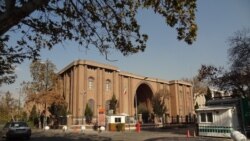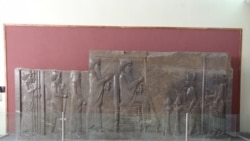Brief and cryptic reports were published in Iranian media August 3 about plans to establish a second branch of the national museum in the basement of the mausoleum of the founder of the Islamic Republic, Ayatollah Khomeini. The plan may reflect an attempt to set up the scene for a personality cult.
The National Museum of Iran, established in 1937, is the country’s “oldest, largest, and most significant” archaeological museum and a top tourist attraction in the capital, Tehran.
Domestic politics, heritage diplomacy and the question of custodianship
Khomeini’s tomb is clearly meant to set up a cult of personality. The extravagance and opulence of the structure that, according to critics from within the Islamic Republic establishment, contradicts Khomeini’s professed care for the oppressed, is in sharp contrast to the relative modesty of the current National Museum building.
The National Museum’s architecture and especially its iconic arch reminds visitors of Persian art of the past and is in harmony with its purpose of displaying archaeological objects.
In contrast, the mausoleum lacks meaningful historical references. It is a cacophony of decorative patterns, shapes and colors scattered over vast dimensions. While impressive, the architecture is foreign to Iranian traditions. Introducing a national museum collection into this context seems anomalous but serves a different purpose.
According to media reports, the new museum will be part of a grand corridor or axis catering to Khomeini’s followers. As early as July 23, Tourism Deputy of the Ministry for cultural Heritage, Vali Teimuri announced that the research project on places associated with Khomeini in Qom, Najaf, Jamaran, and the his Mausoleum was underway and once completed, tourism development for places associated with him would be added to "the collection of the country’s tourism corridors”.
An axis linking Iraq to Tehran with main stations being Jamaran (the residence of Khomeini in north Tehran) through the Mausoleum to the holy Shiite city of Qom and thereon to the holy city of Najaf in Iraq -- the center for training Shiite clergy -- where Khomeini spent time in exile before 1979, is a political gesture.
It is also part of a personality cult promoted for Khomeini, something that is similar to and competes with the cult of Cyrus the Great, the founder of the Achaemenid dynasty and a nationalist symbol. Khomeini’s tomb sets up the scene for this kind of a personality cult.
It is suggested that there will be separate entrances and the museum will be controlled only by the Cultural Heritage Ministry. However, in the Islamic Republic, public institutions are not secure from outside interference and influence. The mausoleum is under the custodianship of Khomeini’s grandson. At any point, he or his colleagues may seek to influence the state of affairs in the national museum.
For decades, the Islamic Republic has been struggling to forge its own version of nationalism centered around first Shiite Islam and then Iran. A new museum will reposition Khomeini, who rejected nationalism and add a nationalist tone to his personality cult, making it part of official propaganda.
Establishing the grand axis, and a museum in it, is also an important gesture in Iran’s regional cultural diplomacy. Already the National Museum has played an important role in heritage diplomacy, a form of international relations focused on cultural heritage. The last popular example of this activity inside Iran was the exhibition in 2018 of Louvre artifacts in Tehran for the occasion of the museum’s 80th anniversary.
A new museum will shift the focus of heritage diplomacy to the Shiite communities in the region. In this sense, it is not completely divorced from regional religious, political and military policies of the Qods Force, the overseas arm of the IRGC.
But in symbolic and cultural terms, Khomeini’s tomb has only achieved limited, official success, perhaps because Khomeini is a political figure first and foremost.
If the grand plan is successful, it can bring together the Islamic Republic’s regional diplomacy, military and strategic aims, and domestic and international tourism together. In this picture, the museum will play a key symbolic and cultural role in terms of heritage diplomacy.
Here, the ramifications of a possible symbolic contradiction between a national collection and Khomeini’s tomb should not be underestimated. As in the existing national museum, the collection and the building itself become national icons and have meanings for visitors.
The current National Museum emphasizes Iranian nationhood. This is incompatible with the mausoleum’s ideological and religious meanings. An important challenge is avoiding the inevitably conflicting images and messages the two produce.
Museum, vault or both?
The purpose of the precise function of the branch is still unclear. Mohammad-Hassan Talebian, the Deputy Minister for Cultural Heritage suggests that it will be a museum starting with 2,000-3,000 exhibits on display and then it can use the 400,000 objects in the vault of the existing National Museum. The vault is essentially a secure storeroom for safekeeping objects that are not on display.
Talebian’s claim is rejected by his colleague, Mohammadreza Karegar, a past Director of the National Museum and present Director General of Museums and Movable Artifacts. Other unnamed sources claimed 40,000 pieces will be transferred to the basement of Khomeini’s Mausoleum, a claim also rejected by Karegar.
The allocated area will be around 25,000 square meters, more than twice that of the existing National Museum at around 11,000 square meters. Therefore, any storage or display in this location will be significant in size.
The need for more space to display thousands of objects is genuine. Even before the 1979 Islamic Revolution, the National Museum of Iran was quickly running out of both exhibition space and storage.
In his brief interview, Karegar referred to UNESCO guidelines for storage and handling of exhibits and said that the new building will aspire to the highest international standards. However, in Iran, there is often a gap between guidelines and practices.
The location of the Mausoleum may pose technical and security challenges. Furthermore, Problems with bad odor and sewage management in the area around the mausoleum are well documented. The chequered record of bodies nominated for the museum or vault’s construction—the IRGC and the Development Jihad—does little to instill confidence in the safety of archaeological treasures.
Also, one has to consider the however remote possibility of accidental damage caused by any attacks on Khomeini's mausoleum.
Reactions and backtracking
The announced plan has caused immediate reactions. A few commentators have taken to twitter to air concerns about the safety of the collections. Others speculate that this is about legitimating and purifying Khomeini’s image. Lack of transparency, shortage detail and contradictory official statements prevent forming an accurate picture and instead encourage speculations and conspiracy theories.
Reacting to virtual protests on online forums by both expats and heritage activists inside Iran, official backtracking began.
Karegar announced “there is no plan for moving the vault and exhibits of the National Museum to this place [the new National Museum]” insisting “one of the places that, because of its standard structural build, may be used in emergency situations is the space in the City of Sun [a new exhibition ground adjacent to the Mausoleum]”.
In a panic-stricken tone, the Voice of Heritage (Sedaye Miras) an official cultural heritage news website, offered an “explanation about unsavoury interpretations of the story of moving the National Museum of Iran’s vault”.
It noted that the explanation was in reaction to “the multitude of interpretations made by many media outlets and activists in Iranian and overseas virtual networks [social media]”.
Such significant popular reactions reveal the sensitivities around cultural heritage within the Iranian society at large, a fact documented and discussed previously by academics.








